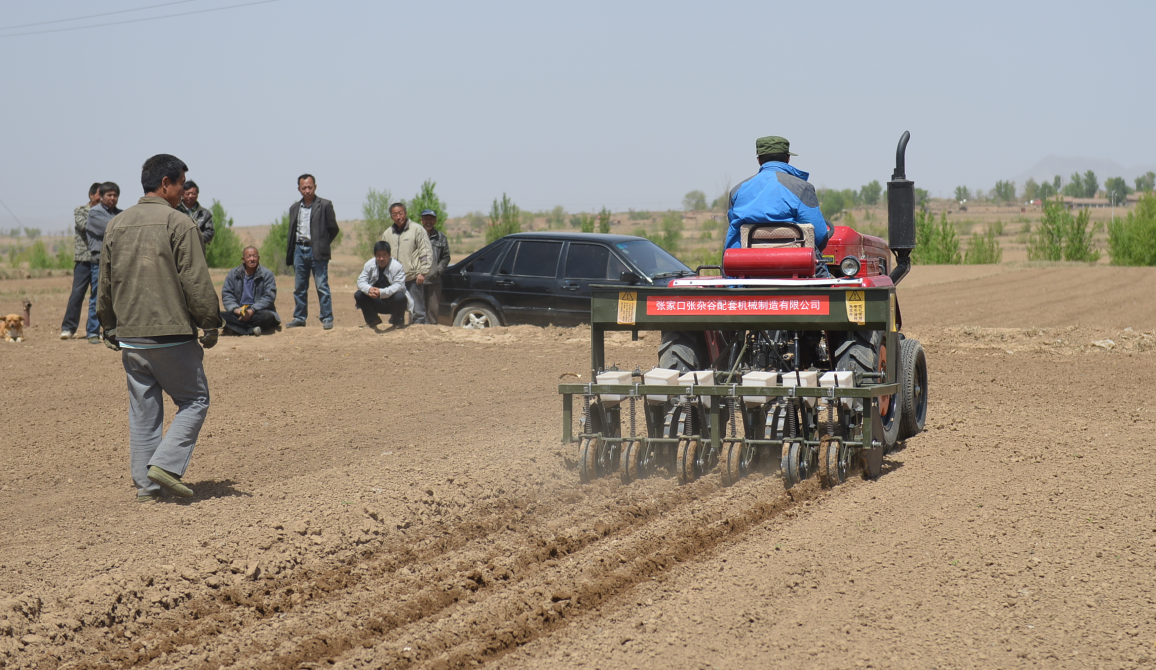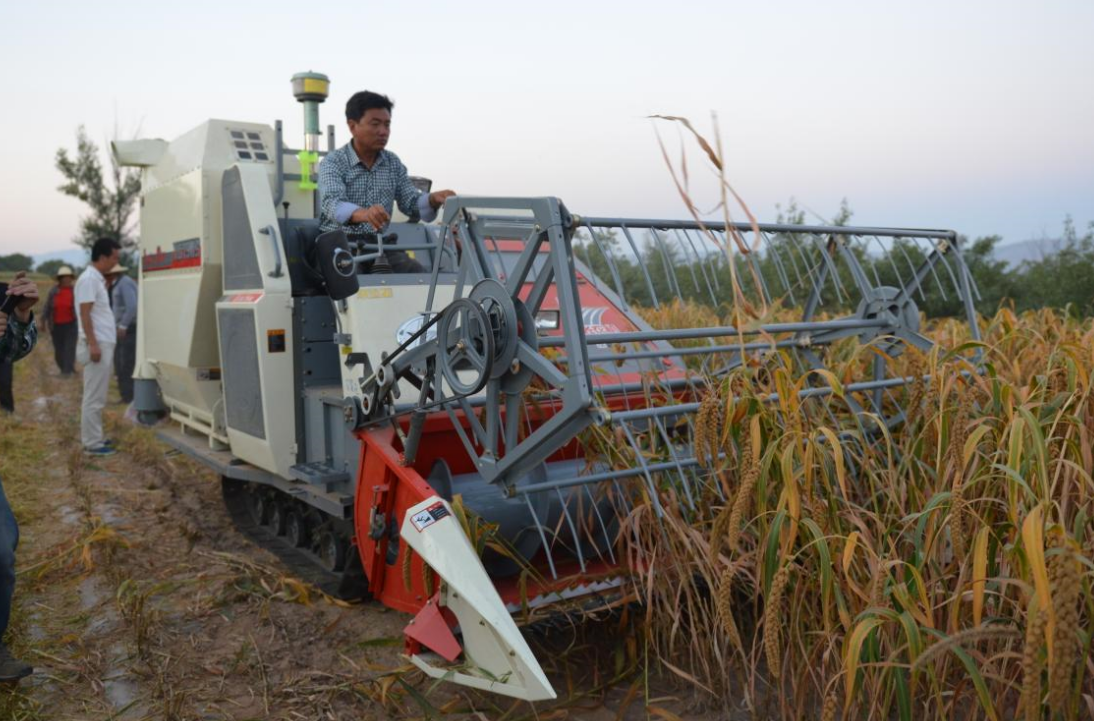In western China, where there is an abundance of land resources but a scarcity of labor, hiring workers is difficult and labor costs are high. Therefore, the model of large-scales, intensive cultivation prevalent in the eastern regions is hard to implement. These areas are suitable for mechanized operations in mall-scale millet cultivation, achieving labor and time efficiency as well as high effectiveness.
Based on many years of large-scale demonstration and promotion, China has summarized mechanized management methods suitable for large-scale contract farmers and professional cooperatives, achieving significant demonstration and promotional effects:
1) Mechanized Sowing Techniques
Mechanized sowing is generally powered by walk-behind tractors or specialized machinery. Its characteristics include uniform seeding, good moisture retention, high work efficiency, and straight rows, saving time and labor and capitalizing on soil moisture conditions to avoid delays in the agricultural season.
● Deep plowing in autumn for moisture conservation and base fertilization, followed by timely harrowing in spring to maintain moisture.
In millet cultivation, planting plans should be made in the previous autumn. After determining the land, timely plowing for moisture conservation is crucial, with the best results achieved when base fertilizer is applied during plowing. The amount of fertilizer applied should be based on the aforementioned base fertilizer rates, primarily using farmyard manure. In spring, when the temperature stabilizes above 10°C, a one-time mechanical operation of rotary tillage and harrowing should be performed quickly. The aim is to finely break the topsoil with fewer clods, ensuring a loose upper layer and a firm lower layer to prevent moisture loss. Avoid spring plowing, which can cause surface soil moisture loss during the sowing period and affect seed germination rates. If spring moisture is excessive or if there is rainfall affecting sowing, plowing to disperse moisture may be necessary.
Top dressing should be applied during the jointing, heading, and early grain-filling stages, spread over 2-3 applications. The first two applications are essential, and the need for a third during the early grain-filling stage depends on whether the millet shows signs of nutrient deficiency. It's important to ensure grain filling while preventing late maturation.

Mechanized sowing techniques
● Using specialized machinery and conducting pre-sowing tests
Prior to sowing, germination tests for each batch of seeds are necessary. The sowing rate per acre should be calculated based on the basic number of seedlings, hybridization rate, thousand-seed weight, and germination rate.
Millet sowing requires uniform seed distribution without missing or interrupted rows, and consistent depth. Post-sowing, immediate compaction is necessary. Sowing can be done using a 30cm row-spacing millet-specific seeder, with recent years favoring precision hole-sowing machinery with film covering. This method completes film covering, soil covering, and compaction in one go. Wheat seeders can also be used, but every alternate hole should be blocked to maintain a row spacing of at least 26cm, ideally adjusted to 30cm, to facilitate mechanical weeding. The sowing depth should be controlled at 4-5cm, and a compaction wheel equipped at the rear of the seeder to ensure one-pass sowing and compaction, improving emergence rate and uniformity. Avoid not compacting after sowing, which can cause uneven emergence and make later management difficult. In areas with severe spring drought and poor soil moisture, the frequency of compaction can be increased to improve emergence rates.
● Comprehensive field management to suppress weed growth
After sowing, chemical herbicides should be used for sealing to effectively prevent weeds, suppressing early weed emergence in the field and reducing weeding costs. A one-time soil surface sealing with a specialized herbicide is recommended. Care should be taken not to seal when seedlings are about to emerge, as it can kill the young plants.
When the millet has 5-6 leaves, timely application of a specialized herbicide is necessary, not only for weed control but also for removing non-hybrid yellow seedlings, achieving chemical weed removal. After this, manual thinning and setting are unnecessary, reducing labor costs. The herbicide can be applied in combination with a broadleaf weed herbicide to prevent or delay later weed problems. After the seedlings have 8 leaves, the use of specialized herbicides should be avoided as it can affect tillering and spike differentiation, leading to deformities.
Additionally, small weeders can be used for inter-row cultivation and earthing up at the 5-leaf stage. Care must be taken to avoid damaging the seedlings. If small weeders are unavailable, large machinery can be used, as seedlings can withstand pressure before the 5-leaf stage and recover upright posture afterward. However, caution is required with large weeders after the 8-leaf stage to avoid plant damage.
2) Mechanized Harvesting Techniques
The complete harvesting process includes reaping, threshing, grain separation, winnowing, drying, sieving, and bagging, as well as subsequent processes such as picking field ears, bundling, and transporting straw. This is the most labor-intensive, time-consuming, and expensive stage of the year, often determining profitability.

Mechanized harvesting techniques
● Controlling the harvest time to reduce post-harvest losses
When using harvesting machinery, it's essential to wait until the millet heads and stems are fully dry and the grains can easily be rubbed out by hand. At this stage, the moisture content of the harvested grains is relatively low, threshing is clean, and the loss rate can be kept below 10%. The threshed millet should be dried promptly, with a grain moisture content below 13% suitable for storage. After harvesting, the millet should be winnowed, sieved, and briefly dried before bagging.
● Utilizing resources fully to extend multiple income streams
Millet is a dual-purpose crop for grain and fodder. If raising cattle or sheep, a scraper and baling machine can be used in one operation to harvest the straw for income. Additionally, field straw can be plowed back into the soil as base fertilizer, enriching the soil fertility.

For more information, please contact WFP China COE (wfpcn.coe@wfp.org)
Category
Mechanized Management Techniques for Hybrid Millet in China
Contributor
Mechanized Management Techniques for Hybrid Millet in China
Country
Technical Solution

